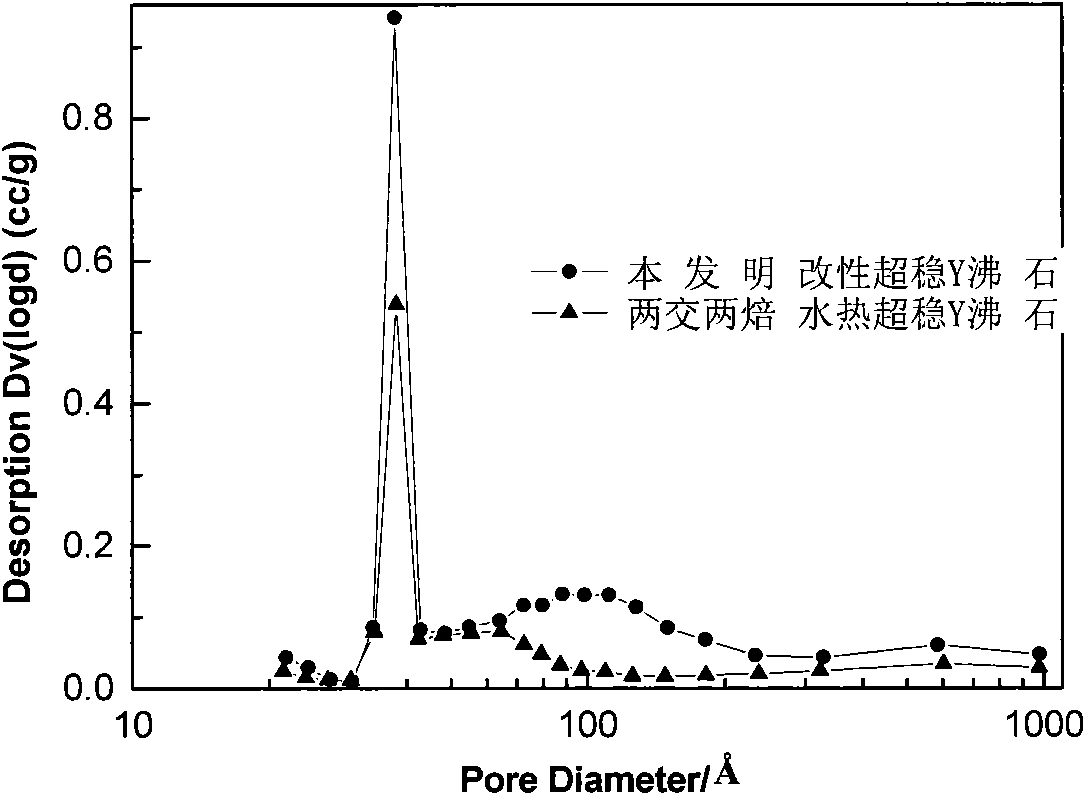Super-stable Y zeolite, preparation method and application thereof
A zeolite and secondary pore technology, which is applied to ultra-stable Y zeolite and its preparation and application fields, can solve the problems of easy destruction of crystal structure, low acid center density, decreased crystallinity and the like, and achieves the selectivity of dry gas and coke. Good, heavy oil conversion ability, high crystallinity effect
- Summary
- Abstract
- Description
- Claims
- Application Information
AI Technical Summary
Problems solved by technology
Method used
Image
Examples
Embodiment 1
[0035] At room temperature, take 1000 grams (dry basis) of DZ1, add it to 10 liters of mixed acid aqueous solution with a concentration of 0.2N oxalic acid and a concentration of 0.1N hydrochloric acid, stir to make it evenly mixed, put it into a reaction kettle, seal it, and fill it with N 2 , keep the pressure of the system at 0.15MPa (gauge pressure), raise the temperature to 100°C at a rate of 10°C / min, keep at this temperature and pressure for 1 hour, filter, wash, and dry at 120°C for 5 hours to obtain the modification The ultra-stable Y-type zeolite sample, denoted as SZ1, table 1 has provided the composition of SZ1, unit cell constant, relative crystallinity, structure collapse temperature, specific surface area and larger pore diameter (pore diameter is ) of secondary pores accounted for the total secondary pores ( ) percentage.
Embodiment 2
[0037] At room temperature, take 2000 grams (dry basis) of DZ1, add it to 20 liters of mixed acid aqueous solution with a concentration of acetic acid of 0.1N and a concentration of hydrochloric acid of 0.15N, stir to make it evenly mixed, put it into a closed pressure reactor, and fill it with N 2 , control the pressure of the reactor to 0.3MPa (gauge pressure), raise the temperature to 115°C at a heating rate of 10°C / min, and keep it at this temperature and pressure for 30 minutes, then filter, wash, and dry the filter cake at 120°C for 5 hours , to get the modified ultrastable Y-type zeolite sample, denoted as SZ2, table 1 has provided the composition of SZ2, unit cell constant, relative crystallinity, structure collapse temperature, specific surface area and larger pore diameter (pore diameter is ) of secondary pores accounted for the total secondary pores ( ) percentage.
Embodiment 3
[0039] At room temperature, take 1500 grams (dry basis) of DZ1, add it to 20 liters of mixed acid aqueous solution with a citric acid concentration of 0.1N and a nitric acid concentration of 0.05N, stir to make it evenly mixed, put it into a closed pressure reactor, and fill it with He Gas, the control system pressure is 0.5MPa, the temperature is raised to 130°C at a rate of 10°C / min, and kept at this temperature and pressure for 10 minutes, then filtered, washed, and the filter cake is dried at 120°C for 5 hours, and the modified The ultra-stable Y-type zeolite sample is denoted as SZ3. Table 1 shows the composition of SZ3, unit cell constant, relative crystallinity, structure collapse temperature, specific surface area and larger pore size (pore size is ) of secondary pores accounted for the total secondary pores ( ) percentage.
PUM
| Property | Measurement | Unit |
|---|---|---|
| specific surface area | aaaaa | aaaaa |
| pore size | aaaaa | aaaaa |
| crystallinity | aaaaa | aaaaa |
Abstract
Description
Claims
Application Information
 Login to View More
Login to View More - R&D
- Intellectual Property
- Life Sciences
- Materials
- Tech Scout
- Unparalleled Data Quality
- Higher Quality Content
- 60% Fewer Hallucinations
Browse by: Latest US Patents, China's latest patents, Technical Efficacy Thesaurus, Application Domain, Technology Topic, Popular Technical Reports.
© 2025 PatSnap. All rights reserved.Legal|Privacy policy|Modern Slavery Act Transparency Statement|Sitemap|About US| Contact US: help@patsnap.com



